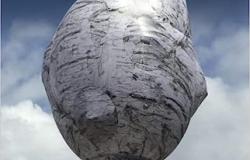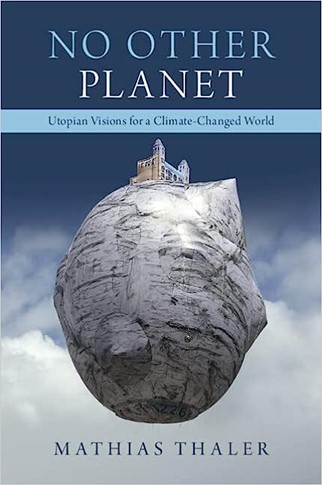Book Review - No Other Planet: Utopian Visions for a Climate-Changed World

No Other Planet: Utopian Visions for a Climate-Changed World by Mathias Thaler. Cambridge: Cambridge University Press 2022. 352 pp., £80 hardcover 9781316516478, £26.99 paperback 9781009015653
In No Other Planet: Utopian Visions for a Climate-Changed World, Mathias Thaler brings together political theory and speculative fiction to ‘rehabilitate’ utopian thinking as a tool for responding to the current climate crisis (p. 6).
Utopian thinking has been criticised for being either wasteful wishful-thinking or dangerous world-building with totalitarian potential (p. 2). As Thaler recounts, liberal theorists such as Karl Popper and Isaiah Berlin rejected utopian-thinking for its seemingly inherent perfectionism that leads (in their account) to extremism and totalitarianism (p. 9). In contrast, Friedrich Engels rejected utopian-thought because it acted as a distraction from the need to take real-life action (p. 57). Thaler uses a more ‘exploratory’ definition to rescue utopianism from the two-pronged critique (p. 3). Building on Miguel Abensour, he proffers that utopianism is the ‘education of a desire for being and living otherwise’ (p. 3).
 In Chapter 2, Thaler outlines his defence of utopianism. If, as he defines it, utopianism is a ‘desire for being and living otherwise’, then ‘otherwise’ can include both being better (eu-topia) and worse (dys-topia) (p. 4). Utopianism is therefore infused with these dual strands of eutopia and dystopia, which can be weaved together with authors placing various emphasis on each strand. In his choice of fictional utopias, Thaler focuses on those that are “this worldly”, meaning that they are set on Earth (p. 26). The three fictional works that he places at the centre of his analysis are N.K. Jemisin’s Broken Earth Trilogy, Kim Stanley Robinson’s Science in the Capital trilogy and Margaret Atwood’s MaddAddam trilogy. These examples of speculative fiction are identified by Thaler not for their proposed solutions; rather Thaler reads them for the rhetorical devices they employ to engage the reader (p. 39). Thaler identifies three ‘mechanisms’ or rhetorical devices of utopianism: estranging, galvanizing and cautioning (p. 3).
In Chapter 2, Thaler outlines his defence of utopianism. If, as he defines it, utopianism is a ‘desire for being and living otherwise’, then ‘otherwise’ can include both being better (eu-topia) and worse (dys-topia) (p. 4). Utopianism is therefore infused with these dual strands of eutopia and dystopia, which can be weaved together with authors placing various emphasis on each strand. In his choice of fictional utopias, Thaler focuses on those that are “this worldly”, meaning that they are set on Earth (p. 26). The three fictional works that he places at the centre of his analysis are N.K. Jemisin’s Broken Earth Trilogy, Kim Stanley Robinson’s Science in the Capital trilogy and Margaret Atwood’s MaddAddam trilogy. These examples of speculative fiction are identified by Thaler not for their proposed solutions; rather Thaler reads them for the rhetorical devices they employ to engage the reader (p. 39). Thaler identifies three ‘mechanisms’ or rhetorical devices of utopianism: estranging, galvanizing and cautioning (p. 3).
Chapters 3, 4, and 5 deal with each of these mechanisms in turn. In Chapter 3, Bruno Latour’s Gaia thesis and N.K. Jemisin’s Broken Earth Trilogy are put in dialogue to consider how plot lines which ask “What If” work to affect cognitive estrangement for the reader. In Chapter 4, Thaler considers the mechanism of galvanizing by reading across ecomodernist theory (broadly concerned with how technology can help ‘de-couple’ humanity from reliance on natural resources (p. 147)) and Kim Stanley Robinson’s Science of the Capital trilogy. These ‘If Only’ plot lines work to motivate the audience to take action. In Chapter 5, dystopian texts are considered for their ability to caution the reader. Specifically, Thaler discusses (post)-apocalyptic thinking and the Dark Mountain project’s manifesto alongside Margaret Attwood’s MaddAddam trilogy.
Throughout, Thaler reads political theory as utopian-literature and in doing so, often (and explicitly) reads texts ‘against the grain’ (p. 99). For example, Latour’s work is not considered to be utopian, and yet in reading it as such Thaler is able to identify the estrangement strategy used by Latour as a way of ‘disrupting conventional representations of our planet and our place within it’ (p. 114). Using a more explanatory definition of utopianism as ‘desire for being and living otherwise’ opens up these productive readings of texts that would not otherwise be considered within a work on utopianism.
The important contribution of Thaler’s analytical framework is in his assertion that within each of these “mechanisms” of utopia there is a fault line (p. 29). A “fault line” is an inbuilt flaw. It is these in-built flaws that protect utopianism against the accusations of perfectionism which can lead to totalitarian world-building; they ensure that utopias remain open-ended and reflective (p. 281). If utopias have purposeful fault lines this rejects the idea of utopias as only being blueprints for ideal worlds. The three fault lines that Thaler identifies are indeterminacy, wishful thinking and defeatism (p. 49). He argues that the role of these fault lines is to create reflective utopian thinking: ‘Only an account of social dreaming that becomes self-reflectively attentive to its weaknesses will be capable of offering orientation in these greatly deranged times’ (p. 281).
One of the fault lines identified by Thaler is ‘wishful thinking’ and this is explored in detail in Chapter 4, where Thaler discusses Robinson’s Science in the Capital trilogy. In this trilogy, Robinson depicts the work of scientists and bureaucrats responding to climate crises in a not-so-distant-future USA. Science in the Capital has been criticised by Andrew Milner for being “utopian”, in the sense that by ignoring the realities of the American political system, the story is implausible and unrealistic.[i] Thaler identifies this and the lack of ‘pushback from a host of powerful stakeholders’ within the novels as an example of wishful thinking (p. 206). It is this wishful thinking that Thaler argues is a fault line in Robinson’s utopia. Wishful thinking ‘glosses over the risks and dangers inherent in the status quo’ (p. 220). But this fault line also works to show that the utopia is a work-in-progress and open-ended (p. 212-213); it highlights the work that needs to be done and the challenges that need to be overcome. Oscillating on this potential fault line in Science in the Capital makes us think about what is meant by ‘politics’, and Lisa Garfoth offers a reading of this trilogy that highlights its representation of a more relational and networked view of politics between institutions.[ii]
Reflecting on this idea of utopia’s fault lines, it is possible to identify other flaws that are hinted at by Thaler. One of these more implicit fault lines is sacrifice. Across her work, Jemisin raises questions about the sacrifices people have to make to support utopian dreams (of their own or of others): ‘insurgent action always needs to be assessed in light of the suffering it will cause’[iii] (p. 134). Thaler highlights the example of human suffering in Science in the Capital as a tactic by Robinson to make readers reflect on ‘the immense losses’ that could arise from some of the policy-interventions (p. 202). This idea of sacrifice sits at the very heart of a utopian short-story by Ursula K Le Guin, ‘The Ones Who Walk Away from Omelas’ (1973), where a child suffers for the community to live in a utopia. Using Thaler’s analytical model, this fault line of sacrifice works to reject ideals of perfectionism and to foreground utopianism’s cognitive mechanisms to provoke reflection.
The book is an excellent example of cross-disciplinary work, bringing together political philosophy, insights from literary studies, and environmental humanities. In that respect, No Other Planet is an important work for scholars working across utopian studies as well as scholars working more broadly on utopian-thought in political philosophy and environmental humanities. Thaler’s theories of utopian fault lines open a productive line of enquiry with the potential for studies to investigate the other fault lines that underpin utopian literature.
Dr. Ruth Houghton is Lecturer in Law at Newcastle University.
[i] Andrew Milner, ‘Guns Under the Table: Kim Stanley Robinson and the Transition to Utopia’ (2020) 31(2) Utopian Studies 388-397, 394
[ii] Lisa Garforth, Green Utopias: Environmental Hope Before and After Nature (Polity Press 2017) 119
[iii] Jessica Hurley and N. K. Jemisin, ‘An Apocalypse Is a Relative Thing: An Interview with N. K. Jemisin’ (ASAP/Journal 3, no. 3, 21 December 2018) 467-77


